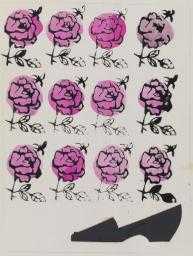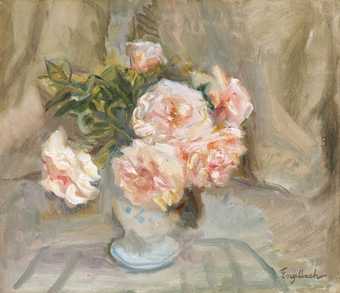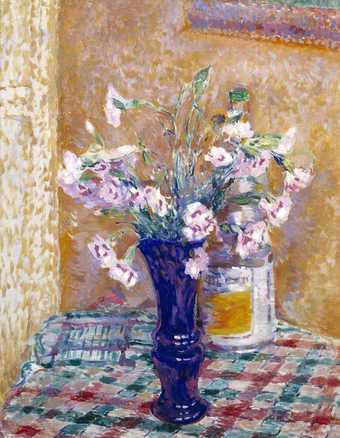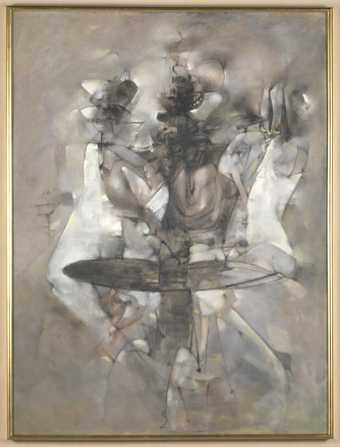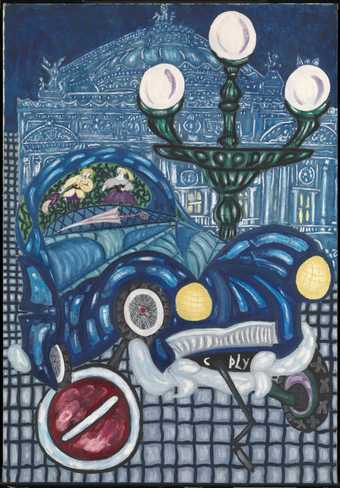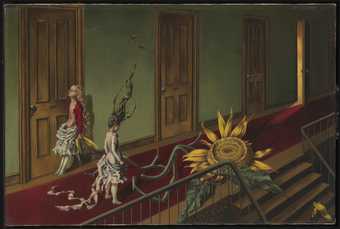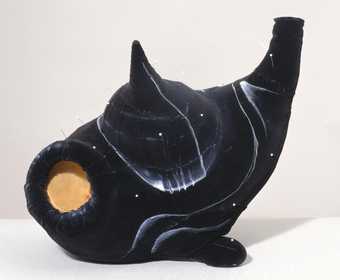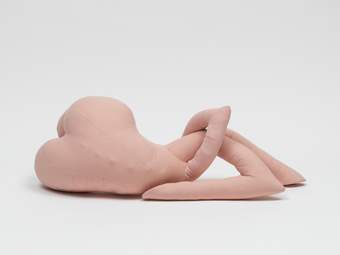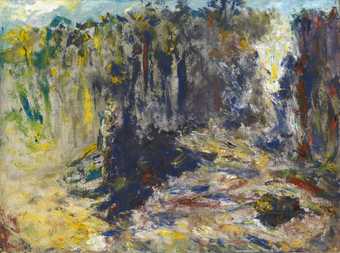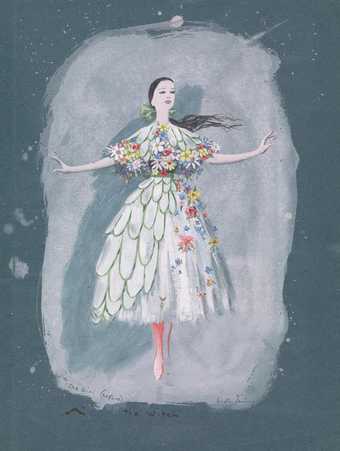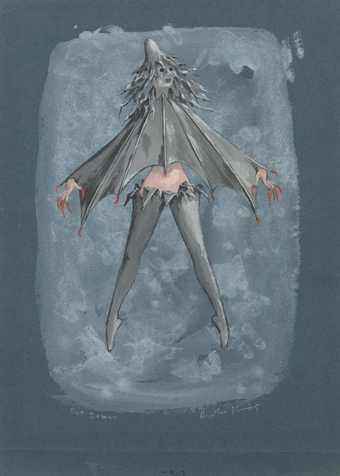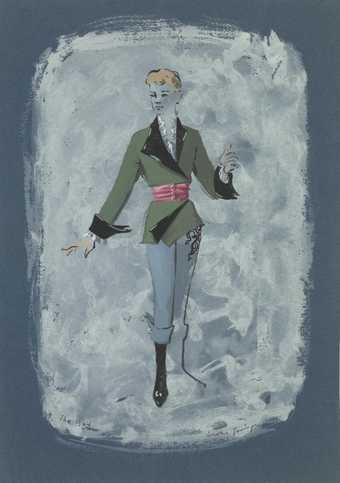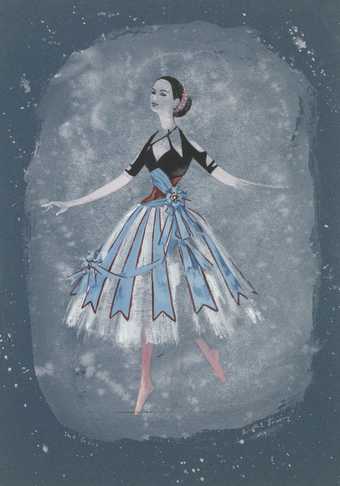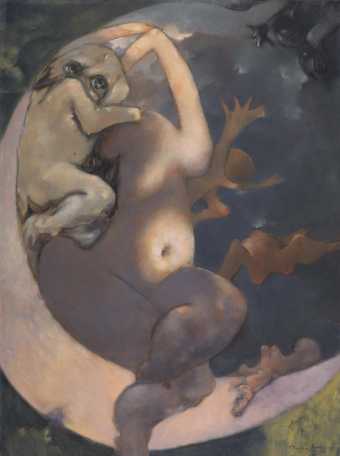
Not on display
- Artist
- Dorothea Tanning 1910–2012
- Medium
- Oil paint on canvas
- Dimensions
- Support: 763 × 1015 × 23 mm
frame: 973 × 1225 × 82 mm - Collection
- Tate
- Acquisition
- Presented by the Tate Collectors Forum 2003
- Reference
- T07987
Summary
Some Roses and Their Phantoms, 1952, represents a domestic world transformed by mysterious eruptions and inhabited by unnamable creatures. The table top setting, with its crisp white tablecloth and marks of ironed folds, suggests a safe world of bourgeois ritual. A recurrent motif, the white table cloth can also be found in other works of the same period, for example, Poached Trout, 1952 (private collection), and Portrait de famille, 1954 (Musée National d’Art Moderne, Centre Georges Pompidou, Paris), and later in Notes for an Apocalypse, 1974 (Mimi Johnson, New York). The theme of domesticity is continued in the suggestion in the foreground of a plain white plate, but this appears to lie under, or more strangely to merge into, the exquisitely painted cloth. In The Rose and the Dog, 1952 (collection of the artist), Tanning painted a single oversize rose, its petals transformed into a grey metallic forms. In Some Roses and Their Phantoms, however, the roses and their phantoms have multiplied and become mysterious, animal-like forms. One emerges from the cloth, its petals shaped like a crumpled napkin; others appear to poke through the background wall. Behind the table another rose-form surges up but resembles only a sad, misshapen creature.
For a recent exhibition of her work Tanning wrote about this painting:
Here some roses from a very different garden sit?, lie?, stand?, gasp, dream?, die? – on white linen. They may serve you tea or coffee. As I saw them take shape on the canvas I was amazed by their solemn colors and their quiet mystery that called for – seemed to demand – some sort of phantoms. So I tried to give them their phantoms and their still-lifeness. Did I succeed? Clearly they are not going to tell me, but the white linen gave me a good feeling as if I had folded it myself, then opened it on the table.
(Dorothea Tanning: Birthday and Beyond, exhibition catalogue, Philadelphia Museum of Art 2000, n.p.)
This painting was bought by Roland Penrose (1900-1984), the British surrealist artist and collector. Penrose had been a close friend of Max Ernst (1891-1976) from the 1920s. He and his wife Lee Miller (1907-1976) remained close friends of Tanning and Ernst, and the couples visited each other from time to time. Penrose had bought the earliest work by Tanning in Tate’s collection, Eine Kleine Nachtmusik, 1943 (Tate T07346), on a visit to the United States in 1946. Penrose contributed an essay to a special volume on Tanning’s work produced by XXe Siècle in 1977.
In this and other works of this period Tanning used a meticulous technique to make the imaginary seem real, albeit imbued with unnatural tones and reflections. Such works can be seen as the culmination of her early work. In the late 1950s, when she had left her home in Sedona, Arizona, and had settled in France, her work entered a freer, more abstracted phase, although still based on allusions to known forms and textures, of which Tate’s A Mi-Voix, 1958 (Tate T00298), is an example.
Further reading
XXe Siècle: Dorothea Tanning, Paris 1977, reproduced p.80 in colour
Jean Christophe Bailly, Dorothea Tanning, New York 1995, reproduced p.79 in colour
Dorothea Tanning, Between Lives: An Artist and Her World, New York and London 2001
Jennifer Mundy
March 2003
Does this text contain inaccurate information or language that you feel we should improve or change? We would like to hear from you.
Display caption
In this painting Tanning questions our expectations of still life painting, transforming a domestic table-top scene. Tanning plays with perspective and introduces mysterious forms and an insect-like creature. She wrote: ‘Here some roses from a very different garden sit?, lie?, stand?, gasp?, dream?, die? – on white linen. They may serve you tea or coffee. As I saw them take shape on the canvas I was amazed by their solemn colours and their quiet mystery that called for – seemed to demand – some sort of phantoms.’
Gallery label, August 2019
Does this text contain inaccurate information or language that you feel we should improve or change? We would like to hear from you.
Catalogue entry
Dorothea Tanning 1910–2012
Some Roses and Their Phantoms
Quelques roses et leurs fantômes
1952
Oil on canvas
759 x 1012 mm
Presented by the Tate Collectors Forum 2003
T07987
Ownership history:
Purchased from the artist by Roland Penrose, Chiddingly, Sussex, in 1954; inherited by Anthony Penrose, Chiddingly, Sussex, in 1984 and sold to the artist, New York, in 2000, from whom purchased by Tate in 2003.
Exhibition history:
References:
Some Roses and Their Phantoms represents a domestic world transformed by mysterious eruptions and inhabited by nightmarish, anthropomorphic creatures. It was made whilst Tanning and her partner the painter Max Ernst (1891–1976) were living in Sedona, Arizona. At this time, Tanning used the stylistic conventions of surrealism to depict fantastic events occurring in mundane or domestic settings, thereby blurring the distinction between the real and the imaginary and creating a world of limitless possibility.
The tabletop setting, with its linen cloth, suggests the conservative, bourgeois environment of Galesburg, Illinois where Tanning was raised. Tanning remembers the weekly domestic ritual of unfolding the crisp, white linen tablecloths in terms of its transformative potential: ‘laying it over the family dining table, so smooth and cool and heavy. It was fascinating to me. The table was transformed by a pattern of sharp creases etched onto the surface, of peaks and troughs that fell over the sides and folded in and around our laps.’1 The theme of mundane domesticity is both reinforced and undermined by the single white plate in the foreground which appears simultaneously to emerge from and recede into the cloth. This is clearly a domestic reality in which the supernatural threatens to invade. From the suggestive topography of the tabletop, three-dimensional avatars emerge half-formed, misshapen, in various stages of etymological or botanical metamorphosis. In the background, disturbances, like stains, threaten to break through the wallpaper. Behind the table a large rose-like form lurks, fixing the viewer, and by implication the diner, with a sombre, melancholy eye.
This same image of folded petals or flower buds transformed into dark, metallic forms which are both pathetic and menacing, reoccurs in many of Tanning’s pictures of the same period, for example The Mirror 1951 (collection of Arno Schefler) and The Rose and the Dog 1952 (collection of the artist). A subversion of the traditional association of flowers (especially roses) with untainted purity and beauty, these motifs are also variations on the idea of the ‘fold’ and what it contains or hides: a perfect metaphor for the human unconscious. Similarly, the recurring motif of the white tablecloth – see, for example, Poached Trout 1952 (private collection), Portrait de Famille 1954 (Musée National d’Art Moderne, Centre Georges Pompidou, Paris) and the later Notes for an Apocalypse 1974 (collection of Mimi Johnson, New York) – is transformed by Tanning in her paintings of the 1940s and 1950s into the copious folds of fabric and drapery that create a sense of anarchic energy.
Some Roses and Their Phantoms was first shown at the Alexandre Iolas Gallery in New York in 1953. It was accompanied by seventeen other paintings, all depicting some variation of folded cloth or flower petals to suggest transformation, mystery and ambiguity in the images presented. On entering the exhibition, the visitor encountered a plaque on the wall with text by the artist:
Interiors with
Windows eggs loud
And soft music,
Tables intruders
Whole families
Nighttimes day-
Times and one
With sudden
joy
The prose-poem clearly indicates what is also visually evident from the Iolas Gallery catalogue for the exhibition, namely that the works in the show were predominantly consistent with Tanning’s customary narrative style. Some Roses and Their Phantoms is the notable exception. What separates this work from the others is the way in which Tanning rejects the depiction of a tableau vivant in favour of what appears to be a magnified view, a detail of the action, with the tablecloth providing the only spatial context for the hybrid ‘roses’. This appears to be a significant psychological departure for Tanning, in whose other works the viewer can find meaning by following a narrative thread. Here, Tanning removes the signposts of conventional pictorial understanding, requiring a more direct, emotional response from the viewer. According to Tanning, Some Roses and Their Phantoms contains ‘an almost primitive, fundamental acceptance of a primarily sensorial world, one in which powerful supernatural forces inhabit the eerie landscapes of both the natural environment and in the recesses of the imagination, particularly the childhood imagination, where the extraordinary can exist unhampered by disbelief or logic’.2 This is perhaps, literally, a child’s eye view of the surrounding reality, one in which the tedium of daily dining has been replaced by a more creative and entertaining construction of the imagination.
In 2000, Some Roses and Their Phantoms was shown at The Philadelphia Museum of Art in a retrospective of Tanning’s work. In the accompanying note for the picture Tanning conflates the image of the tablecloth with that of the canvas, describing the way that the creative process emerges from the smoothed, white surface of both:
Here some roses from a very different garden sit? lie? stand? gasp, dream die? – on white linen. They may serve you tea or coffee. As I saw them take shape on the canvas I was amazed by their solemn colours and their quiet mystery that called for – seemed to demand – some sort of phantoms. So I tried to give them their phantoms and their still-lifeness. Did I succeed? Clearly they are not going to tell me, but the white linen gave me a good feeling as if I had folded it myself, then opened it on the table.3
Surveying the artist’s work, it appears that this painting marks the beginning of a decisive shift away from the narrative and naturalistic style which characterises her work of the 1940s to the experiments with abstraction which she produced from the mid 1950s onwards. According to Tanning, the aim was to open up the possibility for a more immediate, non-intellectual connection between the work and the viewer, ‘one which was not as dependant on words and mediators [art critics] to define what the picture is about but that appeals directly to the imagination and the creative impulse of the viewer’.4
Some Roses and Their Phantoms was bought by Roland Penrose (1900–1984), the British surrealist artist and collector, in 1954. Penrose had been a close friend of Max Ernst’s from the 1920s. He and his wife, the photographer Lee Miller (1907–1976), remained close friends of Tanning and Ernst and the couples visited each other from time to time. In 1946, on a visit to America, Penrose had bought Tanning’s Eine Kleine Nachtmusik 1943 (Tate T07346). In 1977 he contributed an essay to a special volume on Tanning’s work produced by XXe Siècle. Tanning purchased the painting from Penrose’s son Anthony in 2000 and had a restorer remove the discoloured varnish from its surface and carry out any necessary repairs. Tanning herself, as has been her practice when reacquiring works over the past ten years, extensively ‘refreshed’ the paint herself to reinvigorate the painting, particularly the white tablecloth, and to reinstate the mark of her signature.
Victoria Carruthers
March 2010, revised July 2012
Supported by The AHRC Research Centre for the Study of Surrealism and its Legacies.
Notes:
Explore
- emotions, concepts and ideas(16,416)
-
- universal concepts(6,387)
-
- transformation(186)
- domestic(1,795)
- furnishings(3,081)
-
- table(754)
- table cloth(51)
- plate(122)
- magic and occultism(206)
-
- ghost(80)
You might like
-
Andy Warhol Shoes and Roses
1956 -
Florence Engelbach Roses
c.1934–8 -
James Bolivar Manson Pinks in a Vase
c.1940 -
Dorothea Tanning A Mi-Voix
1958 -
William N. Copley Place de l’Opéra
1956 -
Barnett Newman Adam
1951, 1952 -
Dorothea Tanning Eine Kleine Nachtmusik
1943 -
Dorothea Tanning Pincushion to Serve as Fetish
1965 -
Dorothea Tanning Nue couchée
1969–70 -
Jack Butler Yeats A Rose Among Many Waters
1952 -
Dorothea Tanning The Girl (Before)
1950 -
Dorothea Tanning Bat Demon
1950 -
Dorothea Tanning The Boy
1950 -
Dorothea Tanning The Girl
1950 -
Dorothea Tanning Murmurs
1976

